General
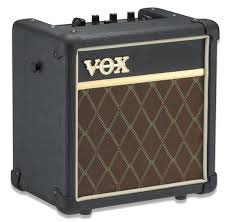
I play in Tin Taxi, an acoustic duo
We do some busking and also the occasional spot in various locations. This is a description of the amp I made.
We had been using a VOX DA5 for busking. It wasn’t bad. It had a guitar input with tone control and lots of special effects which we didn’t use , a single mic input with a volume control and an aux input with no control at all. The sound was good, but it was not really ideal for an acoustic duo. But it had a nice enclosure and a nice speaker, so I used those.
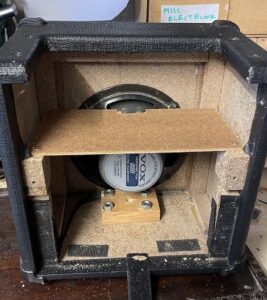
The Power Amp
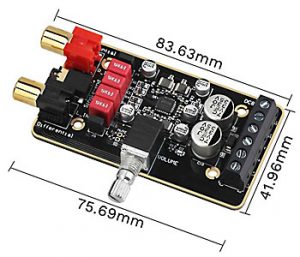 To get the power, I bought a Class D Amp. It is capable of providing 30 Watts (15+15) into 8 ohms with a 24V supply. The module is sold as PAM8620 although that is actually the ID of the chip. It is sold by lots of Chinese suppliers
To get the power, I bought a Class D Amp. It is capable of providing 30 Watts (15+15) into 8 ohms with a 24V supply. The module is sold as PAM8620 although that is actually the ID of the chip. It is sold by lots of Chinese suppliers
Although it is a stereo amp I only use one channel, and a 12V supply. The amp is specified to drive to within a volt of the rails or which gives about 7.5 Watts into an 8 ohm speaker. It has a volume control and I found it could reach max power with only 0.7Vp-p at the input with the volume turned up full giving it a max gain of 40 (or 32dB).
Although the unit is classed as 15 + 15W, specmanship is at work here. The datasheet indicates that the maximum continuous output is 10W per channel at 24V but 15W at 12V. But at 12V, even if we drove to 1V from the rail, that is 11V peak or 7.8V rms or 7.6Winto 8 Ohms. It should theoretically give 15W into 4Ohms, but the data sheet says 8! Basically the datasheet is a mess.
The output is pulse width modulated at 300KHz and a brute to observe on an oscilloscope.
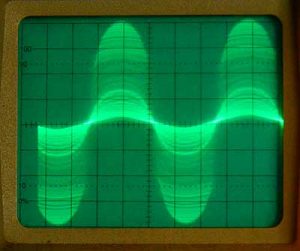
I used an 8 ohm load instead of the speaker to save my eardrums and with a filter across it I could see the waveform.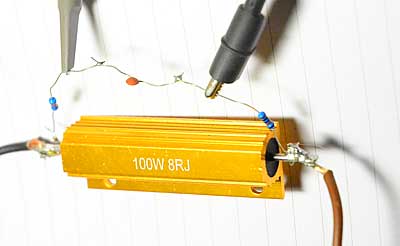
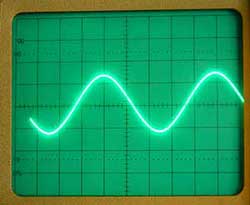
The preamp
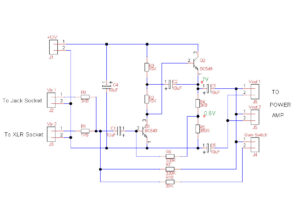
I have used Rod Elliot’s simple mic amp before, so I decided to use it again.
The circuit shows the values modified to work from 9V.
The gain calculates out at about 160, 83, 22, or 11 (in dB that is 44, 38, 27, or 21) depending on the input used and the position of the GAIN switch . This takes into account the DC feedback path, and the limited open loop gain which is around 3400 according to Rod.
The output can swing over 7V p-p from an 12V supply.
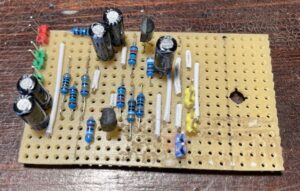
The Power Supply
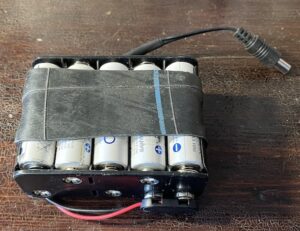 The amp uses uses either 10 rechargeables AA batteries or 8 alkaline C Cells. This means we can generally get over 6 Watts max. During a performance, we are probably averaging 3 Watts (a complete guess). That is 250mA from a 12V supply. Using my best Panasonics I can get well over 1000mAh so these would manage 4 hours use.
The amp uses uses either 10 rechargeables AA batteries or 8 alkaline C Cells. This means we can generally get over 6 Watts max. During a performance, we are probably averaging 3 Watts (a complete guess). That is 250mA from a 12V supply. Using my best Panasonics I can get well over 1000mAh so these would manage 4 hours use.
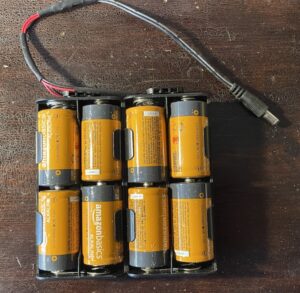 Alkaline C cells are good for around 5000mAh, so that is 20 hours. The plan is to use the rechargeables, but keep the C cells handy for emergencies.
Alkaline C cells are good for around 5000mAh, so that is 20 hours. The plan is to use the rechargeables, but keep the C cells handy for emergencies.
The on/off led starts to dim and is off by the time the voltage drops to 9.9V. At this point, the rechargeables are almost completely flat, but the C Cells, with a more gradual discharge curve, are around half gone. They will supply power down to around 8 Volts. The idea is to use the rechargeables for the main use and the C cells as a backup only.
I used 3 2.7V Zeners, (because that’s all I had) a yellow LED and a 470ohm resistor. I found the LED glowed with only 0.1mA through it so I had to shunt the LED with a resistor. Without the resistor the led would flow down to around 7 Volts. With the resistor it goes off at 10V.
Construction
I cut and bent a piece of aluminium to fit the top and rear aperture copying the DA5 amp measurements and hole spacing.
 I then drilled the aluminium plate to take spire nuts as used by the DA5.
I then drilled the aluminium plate to take spire nuts as used by the DA5.
After fitting to the box and doing a quick test I found the aluminium buzzed like billy-O so i stuck some hardboard to the back using double side sponge tape.
The aluminium did not look “cool” so I covered it in black Gorilla tape.

—
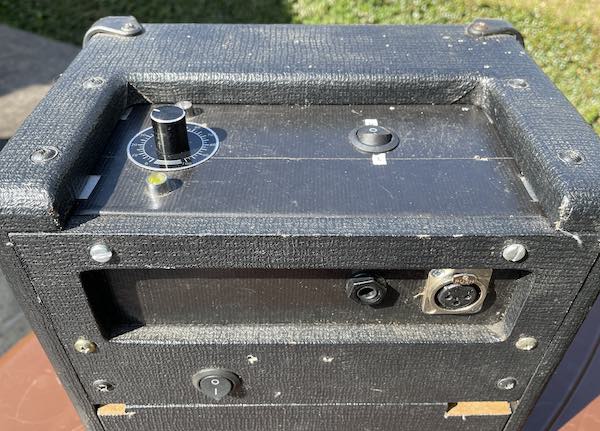
—
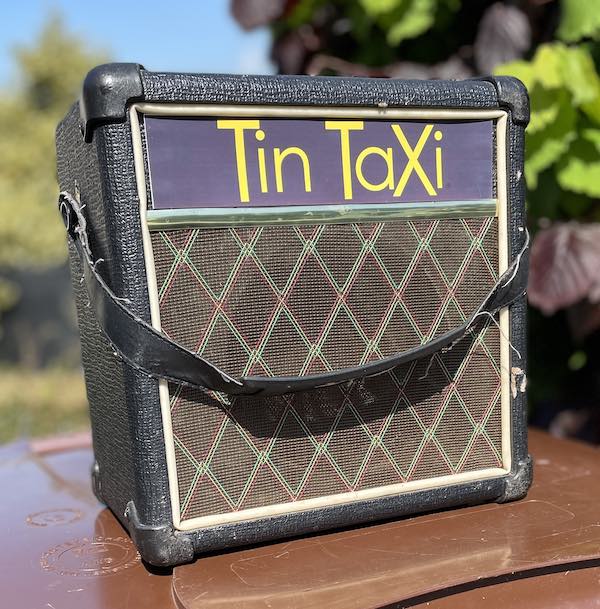
The Stand
We can operate with the amp on the ground, or we can put it mic stand.
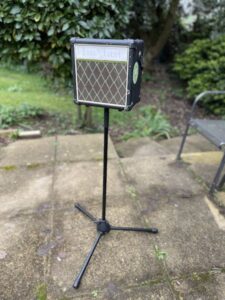
The result
Weight: 4.2Kg with a set of eneloop batteries
Power: I can get 18V p-p into 8ohms before clipping sets in. That is 9V peak. The difference between that and the expected 11V peak may be due to lead resistance between the battery and the speaker plus the internal resistance of the battery. A total of 1.7 Ohms would account for it. That means the output power is around 1.8dB down on the optimum – this would be hardly discernable by ear.
It is worth remembering that the Beatles played with VOX AC30 amps which are 30 Watts. Now that is 6 times the power that my amp has (assuming the VOX rating is honest – it certainly wasn’t on my DA5!). On the power scale that is 8dB louder – it takes 10dB to sound twice as loud. So we can have a volume a bit over half what John or Paul had.
(Note: The original DA5 would not manage more then 3Watts without clipping on batteries, and clipping caused horrible distortion.)
Overall the amp is very simple to use.
- Put it on the stand if necessary
- plug in the mics
- Put the GAIN switch to HI, and the volume to low.
- Switch on and increase the volume till it sounds “right” (usually a little bit lower than feedback setting in)
- If the volume setting is below 30, switch the GAIN switch to LO and increase the volume until it sounds right. (This step is to avoid saturation and distortion in the pre-amp)
Update 26 June 2023
I decided to change to a lead acid battery. I am using a Lucas 2.3AH 12 Battery which cost me £14.95 from ebay. My logic is:-
- The AA eneloops are fine, but they have to be taken out of the amp and out of the holder to recharge. My old 7day shop charger does 8 at a time, so as I use 10 batteries, it takes two goes. The charger also is a bit temperamental – I have had it over 15 years.
- The C cells work fine too, and they should last a long time. But I’d worry that they (or one of the eight fitted) will give up in the middle of a gig. So I’d be carrying a backup solution.
- A lead acid battery can be charged while still in the amp with either my Ctek car battery charger or in the car via the cigar lighter socket. So it can be charged easily in between gigs. The battery is 2.3Ah and if I discharge it to 50% that is 1.15Ah or 13.8Wh. That’s about the same as my eneloops, but, in an emergency, the lead acid could go further if I allow it to discharge to under 50%. This is not good for a lead acid battery but it should only happen very occasionally, if at all.
I decided the weight increase of 520gm or 12% was worth it.
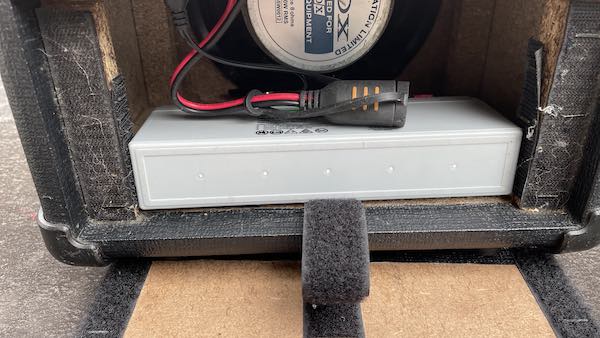
I am also finding that the little standalone preamp works very well so the built in preamp is not getting used much. I have fitted an “Ext in” socket which feeds directly to the power amp.
I have found a trolley that also lifts the amp of the ground as well as carrying the mic stand and all the rest of the equipment apart from instruments.
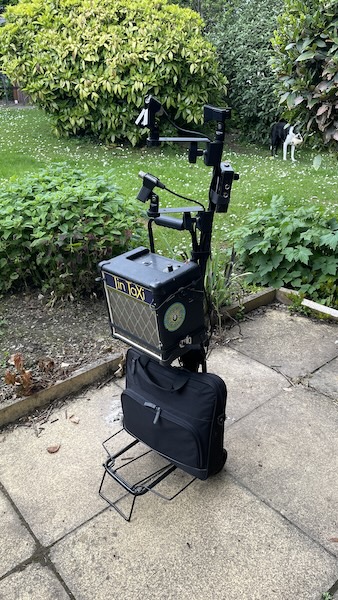

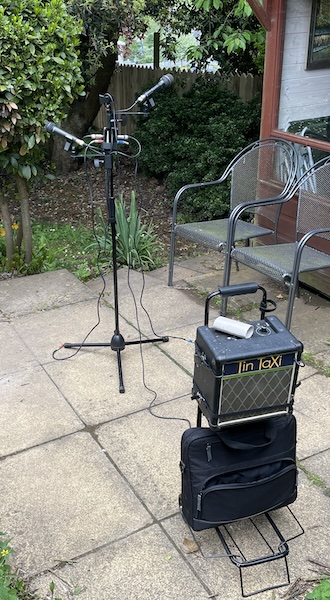
The next mod will probably be a tone control circuit mounted in the amp somewhere. Electrically it will fit just before the input tp the power amp. Physically?? TBD.
If the Amp is not enough
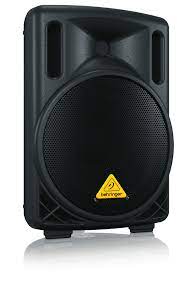
The amp is surprisingly loud and is enough for a small to medium sized room. But if we need more sound, we also have a Behringer B208D active speaker which is supposedly good for 200W. It works of the mains 240V, but it will work from my little 300w inverter (out of the motorhome) and the Alphaline battery which is around 35Ah. There is some buzz as the inverter is not pure sinewave, but it would be OK in an environment which was not very quiet.
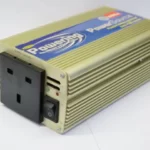
I found that the speaker + inverter take around 1.6A quiescent current from the battery. I guess that on full power the average power will be round 20W (yes, a complete guess) which is another 1.6A so we will be drawing around 3.2A from the battery. So a good few hours from the battery would not be a problem
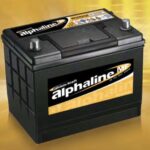
The little preamp works well with the Behringer too.
But the whole kaboodle is very heavy to lug about. It’s a lot lighter if we can get a mains connection and leave the battery and the inverter. It will all fit on the trolley above.
